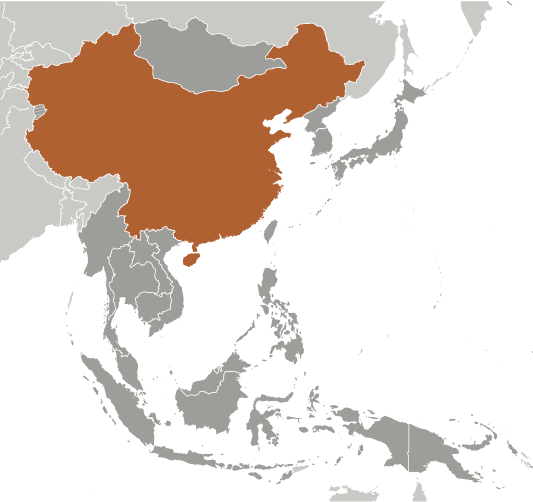|
Country name:
|

|
|
conventional long form: People's Republic of China
conventional short form:
China
local long form:
Zhonghua Renmin Gongheguo
local short form:
Zhongguo
abbreviation:
PRC
|
|
|
Government type:
|

|
|
Communist state
|
|
|
Capital:
|

|
|
name: Beijing
geographic coordinates:
39 55 N, 116 23 E
time difference:
UTC+8 (13 hours ahead of Washington, DC during Standard Time)
note:
despite its size, all of China falls within one time zone; many people in Xinjiang Province observe an unofficial "Xinjiang time zone" of UTC+6, two hours behind Beijing
|
|
|
Administrative divisions:
|

|
|
23 provinces (sheng, singular and plural), 5 autonomous regions (zizhiqu, singular and plural), and 4 municipalities (shi, singular and plural)
provinces:
Anhui, Fujian, Gansu, Guangdong, Guizhou, Hainan, Hebei, Heilongjiang, Henan, Hubei, Hunan, Jiangsu, Jiangxi, Jilin, Liaoning, Qinghai, Shaanxi, Shandong, Shanxi, Sichuan, Yunnan, Zhejiang; (see note on Taiwan)
autonomous regions:
Guangxi, Nei Mongol (Inner Mongolia), Ningxia, Xinjiang Uygur, Xizang (Tibet)
municipalities:
Beijing, Chongqing, Shanghai, Tianjin
note:
China considers Taiwan its 23rd province; see separate entries for the special administrative regions of Hong Kong and Macau
|
|
|
Independence:
|

|
|
1 October 1949 (People's Republic of China established); notable earlier dates: 221 BC (unification under the Qin Dynasty); 1 January 1912 (Qing Dynasty replaced by the Republic of China)
|
|
|
National holiday:
|

|
|
Anniversary of the founding of the People's Republic of China, 1 October (1949)
|
|
|
Constitution:
|

|
|
most recent promulgation 4 December 1982; amended several times
|
|
|
Legal system:
|

|
|
civil law influenced by Soviet and continental European civil law systems; legislature retains power to interpret statutes; note - criminal procedure law revised in early 2012
|
|
|
International law organization participation:
|

|
|
has not submitted an ICJ jurisdiction declaration; non-party state to the ICCt
|
|
|
Suffrage:
|

|
|
18 years of age; universal
|
|
|
Executive branch:
|

|
|
chief of state: President XI Jinping (since 14 March 2013); Vice President LI Yuanchao (since 14 March 2013)
head of government:
Premier LI Yuanchao (since 16 March 2013); Executive Vice Premier ZHANG Gaoli (16 March 2013), Vice Premier LIU Yandong (since 16 March 2013), Vice Premier MA Kai (since 16 March 2013), and Vice Premier WANG Yang (since 16 March 2013)
cabinet:
State Council appointed by National People's Congress
(For more information visit the World Leaders website  ) )
elections:
president and vice president elected by National People's Congress for a five-year term (eligible for a second term); elections last held on 5-17 March 2013 (next to be held in March 2018); premier nominated by president, confirmed by National People's Congress
election results:
XI Jinping elected president by National People's Congress with a total of 2,952 votes; LI Yuanchao elected vice president with a total of 2,940 votes
|
|
|
Legislative branch:
|

|
|
unicameral National People's Congress or Quanguo Renmin Daibiao Dahui (2,987 seats; members elected by municipal, regional, and provincial people's congresses, and People's Liberation Army to serve five-year terms)
elections:
last held in December 2007-February 2008 (next to be held in late 2012 to early 2013)
election results:
percent of vote - NA; seats - 2,987
note:
in practice, only members of the CCP, its eight allied parties, and CCP-approved independent candidates are elected
|
|
|
Judicial branch:
|

|
|
Supreme People's Court (judges appointed by the National People's Congress); Local People's Courts (comprise higher, intermediate, and basic courts); Special People's Courts (primarily military, maritime, railway transportation, and forestry courts)
|
|
|
Political parties and leaders:
|

|
|
Chinese Communist Party or CCP [XI Jinping]; eight nominally independent small parties ultimately controlled by the CCP
|
|
|
Political pressure groups and leaders:
|

|
|
no substantial political opposition groups exist
|
|
|
International organization participation:
|

|
|
ADB, AfDB (nonregional member), APEC, ARF, ASEAN (dialogue partner), BIS, CDB, CICA, EAS, FAO, FATF, G-20, G-24 (observer), G-77, IADB, IAEA, IBRD, ICAO, ICC (national committees), ICRM, IDA, IFAD, IFC, IFRCS, IHO, ILO, IMF, IMO, IMSO, Interpol, IOC, IOM (observer), IPU, ISO, ITSO, ITU, LAIA (observer), MIGA, MINURSO, MONUSCO, NAM (observer), NSG, OAS (observer), OPCW, PCA, PIF (partner), SAARC (observer), SCO, SICA (observer), UN, UNAMID, UNCTAD, UNESCO, UNFICYP, UNHCR, UNIDO, UNIFIL, UNISFA, UNMIL, UNMISS, UNMIT, UNOCI, UNSC (permanent), UNTSO, UNWTO, UPU, WCO, WHO, WIPO, WMO, WTO, ZC
|
|
|
Diplomatic representation in the US:
|

|
|
chief of mission: Ambassador ZHANG Yesui; Ambassador-Designate CUI Tiankai
chancery:
3505 International Place NW, Washington, DC 20008
telephone:
[1] (202) 495-2266
FAX:
[1] (202) 495-2138
consulate(s) general:
Chicago, Houston, Los Angeles, New York, San Francisco
|
|
|
Diplomatic representation from the US:
|

|
|
chief of mission: Ambassador Gary LOCKE
embassy:
55 An Jia Lou Lu, 100600 Beijing
mailing address:
PSC 461, Box 50, FPO AP 96521-0002
telephone:
[86] (10) 8531-3000
FAX:
[86] (10) 8531-3300
consulate(s) general:
Chengdu, Guangzhou, Shanghai, Shenyang, Wuhan
|
|
|
Flag description:
|

|
|
red with a large yellow five-pointed star and four smaller yellow five-pointed stars (arranged in a vertical arc toward the middle of the flag) in the upper hoist-side corner; the color red represents revolution, while the stars symbolize the four social classes - the working class, the peasantry, the urban petty bourgeoisie, and the national bourgeoisie (capitalists) - united under the Communist Party of China
|
|
|
National symbol(s):
|

|
|
dragon
|
|
|
National anthem:
|

|
|
name: "Yiyongjun Jinxingqu" (The March of the Volunteers)
lyrics/music:
TIAN Han/NIE Er
note:
adopted 1949; the anthem, though banned during the Cultural Revolution, is more commonly known as "Zhongguo Guoge" (Chinese National Song); it was originally the theme song to the 1935 Chinese movie, "Sons and Daughters in a Time of Storm"
|
|
|
|
|





 )
)



